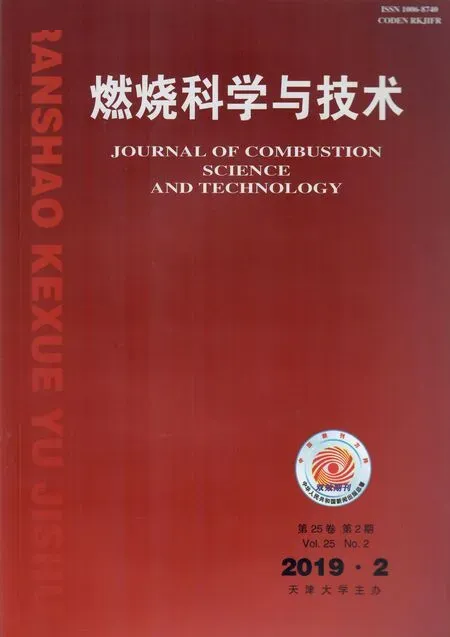气固两相燃烧双流体大涡模拟的数学模型
周力行
气固两相燃烧双流体大涡模拟的数学模型
周力行
(清华大学工程力学系,北京 100084)
目前大多数两相燃烧的大涡模拟(large-eddy simulation,LES)是欧拉-拉氏模拟,这比欧拉-欧拉或双流体模拟耗时大得多.本文提出气固两相燃烧双流体大涡模拟的数学物理模型,包括双流体框架内大涡模拟过滤的控制方程,两相亚网格(sub-grid scale,SGS)应力模型和亚网格气体燃烧模型.对亚网格应力本文建议用作者提出的两相亚网格动能方程模型,考虑两相之间的相互作用.对气体(挥发分和CO)燃烧建议用作者提出的二阶矩(second-order moment,SOM)亚网格湍流-反应相互作用模型.对颗粒的热解挥发和焦炭燃烧模型也在双流体模型的框架内加以应用.这些子模型已经分别通过和实验对照加以评估.
双流体模型;大涡模拟;气固两相燃烧
近年来两相燃烧的大涡模拟(large-eddy simulation,LES)引起了越来越多的注意,这是因为它可以给出瞬态流动和火焰结构,比雷诺平均(Reynolds-averaged Navier-Stokes,RANS)模拟得到的统计结果更准确,同时又比直接数值模拟(direct numerical simulation,DNS)的计算量小得多,能用于解决实际工程问题.目前绝大多数的LES 用欧拉-拉氏(Eulerian-Lagrangian,E-L)模拟[1-6].从RANS模拟的经验中已经了解到颗粒的拉氏模拟:①难以给出复杂几何形状的三维空间内各处的颗粒速度、温度和浓度的详细连续分布;②常常低估颗粒的弥散[7];③颗粒难以进入或离开边角回流区;④要提高计算精度须计算大量的轨道,这就要有很大的计算量.另一方面,欧拉-欧拉(Eulerian-Eulerian,E-E)或者双流体模拟在两相流动燃烧的RANS 模拟中已经得到成功的发展和应用[8].它可以比E-L 模拟用少得多的计算量给出详细的颗粒信息.因此有必要研究双流体大涡模拟.
无论是E-L还是E-E的LES,其模拟的合理性和精度取决于:①足够细的网格;②比RANS 模拟用更精确的差分格式;③合适的亚网格(sub-grid scale,SGS)应力和燃烧模型.在E-L模拟中,往往对气体用单相流动的SGS 应力模型,没有颗粒的SGS应力模型.最普遍应用的是Smagorinsky涡粘模型[9],Germano动态涡粘模型[10]和Kim的SGS动能方程模型[11],其中不考虑颗粒对气体SGS应力的影响. Yuu等[12]和Zhou等[13]分别提出了有颗粒作用的气体SGS应力模型.Boileau等[14]和Moreau等[15]报导了两相燃烧的双流体大涡模拟,其中对颗粒也采用了仿效气体Smagorinsky的模型,没有考虑两相之间的相互作用.作者建议将本文提出的两相SGS 动能方程模型[16]用于两相燃烧双流体大涡模拟中.
对LES中的气体燃烧模型,常常是在预混燃烧中用G 方程或线性涡模型,在非预混燃烧中用层流火焰面模型.然而这些模型只适用于特定类型或特定结构的火焰.过滤的概率密度方程模型的适用性比较广,但是在LES中的计算量非常大.本文作者提出了二阶矩(second-order moment,SOM)燃烧模 型[17],已经成功地用于单相气体预混和非预混燃烧以及两相燃烧的E-L LES[18],计算量不大.因此本文中将此模型用于气固两相燃烧的双流体LES.
本文将给出气固两相燃烧双流体大涡模拟的数学物理模型,包括双流体框架下特有的过滤后的控制方程,两相亚网格应力模型,亚网格气体燃烧模型,颗粒热解挥发和焦炭燃烧模型等.
1 气固两相燃烧双流体大涡模拟过滤的控制方程
取白噪音过滤,即计算网格内的体积平均,可以得到气固两相燃烧的双流体大涡模拟过滤后的气体连续和气体组分及气体和颗粒的、动量和能量方程:

(1)

(2)


(3)

(4)

(5)


(6)
气固两相燃烧的双流体模拟中,要有诸多的颗粒连续方程,即颗粒的数密度、总质量、干而无灰(dry and ash free,DAF)的煤以及颗粒水分的守恒方程.

(7)

(8)


(9)

(10)
由于水分蒸发、热解挥发和焦炭燃烧导致的颗粒质量变化率决定于

(11)


(12)

(13)

(14)

(15)

(16)

(17)
2 两相亚网格动能方程模型
本文作者提出的两相亚网格动能方程模型[14]中,过滤后的气体和颗粒黏性力是

两相亚网格应力可以表现为各向同性的,可以定义为



其耗散率分别是

这里D是亚网格尺寸.两相亚网格动能取决于

(18)

(19)

两相速度关联方程是


(20)
3 亚网格质量流和热流模型
两相的亚网格质量流和热流用梯度模拟封闭,即

(21)

(22)

(23)

(24)
4 二阶矩亚网格(SOM-SGS)气体燃烧模型
取一步总包反应机理,SOM-SGS 气体(CO 和挥发分)燃烧模型[16]表达为


(25)



(26)
5 结 论
(1)本文提出了气固两相燃烧双流体大涡模拟的数学物理模型,包括过滤后的控制方程,两相亚网格应力模型,亚网格气体燃烧模型,颗粒热解挥发和焦炭燃烧模型.
(2)气固两相燃烧的双流体大涡模拟中有多个颗粒连续方程.
(3)所提出的两相亚网格应力模型考虑了两相之间的相互作用.
[1] Li Y H,Kong S C. Diesel combustion modeling using LES turbulence model with detailed chemistry[J].,2008,12(2):205-219.
[2] Moin P,Apte S V. Large-eddy simulation of realistic gas turbine combustors[J].,2006,44(4):698-708.
[3] Patel N,Menon S. Simulation of spray-turbulence-flame interactions in a lean direct injection combustor[J].,2008,153(1/2):228-257.
[4] Yan Y W. Large-eddy simulation of two-phase spray combustion for gas turbine combustors[J].,2008,28(11):1365-1374.
[5] 隋春杰,杨 帆,孔文俊. 旋流贫预混燃烧湍流特性的大涡模拟[J]. 燃烧科学与技术,2017,23(1):22-28.
Sui Chunjie,Yang Fan,Kong Wenjun.Large eddy simulation of turbulence characteristics in swirling premixed flame[J].,2017,23(1):22-28(in Chinese).
[6] 夏一帆,杨瑶,王高峰,等. 甲烷/空气预混射流火焰的大涡模拟[J]. 燃烧科学与技术,2017,23(4):305-312.
Xia Yifan,Yang Yao,Wang Gaofeng,et al.Large-eddy simulation of premixed methane/air jet flames[J].,2017,23(4):305-312(in Chinese).
[7] Li L,Zhou L X,Li R X,et al. Simulation of 3-D gas-particle flows and coal combustion in a tangentially fired furnace using a two-fluid-trajectory model[J].,2002,125(2/3):226-233.
[8] Zhou L X. A review for developing two-fluid modeling and LES of turbulent combusting gas-particle flows[J].,2016,297:438-447.
[9] Smagorinsky J. General circulation experiments with the primitive equation(I):The basic experiment[J].1963,91:99-164.
[10] Germano M,Piomelli U,Moin O,et al. A dynamic sub-grid-scale eddy viscosity model[J].,1991,A3:1760-1765.
[11] Kim W W,Menon S S. A new dynamic one-equation sub-grid-scale model for large eddy simulation[C]// 33USA,1995,DOI:10. 2514/6. 1995-356.
[12] Yuu S,Ueno T,Umekage T,et al. Numerical simulation of the high Reynolds number slit nozzle gas-particle jet using sub-grid-scale coupling large eddy simulation [J].,2001,56(14):4293-4307.
[13] Zhou H S,Flamant G,Gauthier D,et al. DEM-LES of coal combustion in a bubbling fluidized bed (Ⅰ):gas-particle turbulent flow structure[J].,2004,59:4193-4203.
[14] Boileau M,Pascaud S,Riber E,et al. Investigation of two-fluid methods for large eddy simulation of spray combustion in gas turbines[J].,2008,80(3):291-321.
[15] Moreau M,Simonin O,Bédat B. Development of gas-particle Euler-Euler LES approach:A priori analysis of particle sub-grid models in homogeneous isotropic turbulence[J].,,2010,84(2):295-324.
[16] 刘 阳,周力行,许春晓. 两相亚网格动能方程模型[C]//中国工程热物理学会多相流学术会议. 吉林,2009,094038.
Liu Yang,Zhou Lixing,Xu Chunxiao. Two-phase sub-grid scale energy equation model[C]//Jilin,2009,094038(in Chinese).
[17] Zhou L X,Qiao L,Chen L X. A USM turbulence-chemistry model for simulating NO formation in turbulent combustion[J].,2002,81(13):1703-1709.
[18] Zhou L X,Wang F,Hu L Y,et al. A review on studies of a SOM combustion model for single-and-two-phase combustion[J].,2016,96:154-163.
Mathematical Models for Two-fluid LES of Gas-solid Two-phase Combustion
Zhou Lixing
(Department of Engineering Mechanics,Tsinghua University,Beijing 100084,China)
At present,most large-eddy simulation(LES) of two-phase combustion adopt the Eulerian-Lagrangian approach,which requires much longer computational time than the Eulerian-Eulerian,i.e.,the two-fluid approach.This paper proposes mathematical models for the two-fluid LES of gas–solid two-phase combustion,including filtered controlling equations specific for two-fluid modeling,a two-phase sub-grid scale(SGS) stress model,and a SGS combustion model.ForSGS stress models,a two-phase SGS energy equation model that accounts for the interaction between two phases is proposed. For the gas-phase (volatiles and CO) combustion,the second-order moment SGS (SOM-SGS) turbulence-chemistry model,which is proposed by the present author,is suggested. The coal pyrolization and char combustion models are also used in the framework of two-fluid modeling. These models are assessed separately by comparison with experimental findings.
two-fluid modeling;large-eddy simulation(LES);gas-solid two-phase combustion
TK16
A
1006-8740(2019)02-0095-04
2018-12-13.
国家自然科学基金资助项目(51390493).
周力行(1932— ),男,博士,教授.
周力行,zhoulx@mail.tsinghua.edu.cn
10.11715/rskxjs.R201812013

